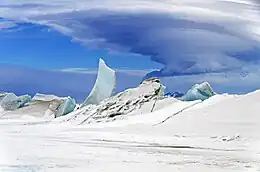Lenticular cloud
Lenticular clouds (Latin: Lenticularis lentil-shaped, from lenticula lentil) are stationary clouds that form mostly in the troposphere, typically in parallel alignment to the wind direction. They are often comparable in appearance to a lens or saucer. Nacreous clouds that form in the lower stratosphere sometimes have lenticular shapes.
| Lenticular cloud | |
|---|---|
 Dramatic lenticular cloud formation over Harold's Cross, Dublin | |
| Genus | Stratocumulus, altocumulus, cirrocumulus |
| Species | lenticularis (Latin: lentil) |
| Altitude | up to 12,000 m (40,000 ft) |
| Appearance | lens-like, Saucer-shaped |
| Precipitation | Virga only. |

There are three main types of lenticular clouds: altocumulus standing lenticular (ACSL), stratocumulus standing lenticular (SCSL), and cirrocumulus standing lenticular (CCSL), varying in altitude above the ground. Because of their unique appearance, they have been suggested as an explanation for some unidentified flying object (UFO) sightings.
Formation and appearance

As air travels along the surface of the Earth, obstructions are often encountered, including natural features, such as mountains or hills, and artificial structures, such as buildings and other constructions, which disrupt the flow of air into "eddies", or areas of turbulence.
When moist, stable air flows over a larger eddy, such as those caused by mountains, a series of large-scale standing waves form on the leeward side of the mountain. If the temperature at the crest of the wave drops below the dew point, moisture in the air may condense to form lenticular clouds. Under certain conditions, long strings of lenticular clouds may form near the crest of each successive wave, creating a formation known as a "wave cloud". Those wave systems can produce large updrafts, occasionally enough for water vapour to condense and produce precipitation.[1]
Lenticular clouds have been said to be mistaken for UFOs, because many of them have the shape of a "flying saucer", with a characteristic "lens" or smooth, saucer-like shape. Lenticular clouds generally do not form over low-lying or flat terrain, so many people may have never seen one before and don't know that they can exist.[2][nb 1] Bright colours (called iridescence) are sometimes seen along the edge of lenticular clouds.[3]
Flight
Pilots of powered aircraft tend to avoid flying near lenticular clouds because of the turbulence and sinking air of the rotor generated at the trailing edge of these clouds, but glider pilots actively seek them out in order to climb in the upward moving air at the leading edge. The precise location of the rising air mass is fairly easy to predict from the orientation of the clouds. "Wave lift" of this kind is often very smooth and strong, and enables gliders to soar to remarkable altitudes and to cover great distances. As of 2020, the gliding world records for both distance (over 3,000 km; 1,864 mi)[4] and absolute altitude ( (over 22,000 metres; 74,334 ft)[5] were set using such lift.
See also
- Cloud Appreciation Society
- Pileus (meteorology), or cap cloud
Notes
- Lenticular clouds have also been known to form in cases where a mountain does not exist, but rather as the result of shear winds created by a front.
References
- "Altocumulus Standing Lenticular Clouds". National Weather Service. NOAA. Retrieved 9 March 2018.
- Byrd, Deborah (19 January 2021). "Lenticular clouds look like UFOs". EarthSky. Retrieved 3 May 2022.
- Atmospheric Optics: Iridescent Clouds
- "Klaus Ohlmann (GER) (7605) | World Air Sports Federation". www.fai.org. 2017-10-10. Retrieved 2022-11-22.
- "Records". www.fai.org. 2017-08-03. Retrieved 2020-10-05.
External links
- BBC image gallery of lenticular clouds over Yorkshire in 2011
- Lenticular cloud seen from Palm Desert, California, in April 2008
- kcocco.com Altocumulus Lenticular Clouds, Wasatch Mountains, Utah
- NASA Astronomy Picture of the Day: Picture of the Day 2009-01-21: A lenticular Cloud over New Zealand (21 January 2009)
- Sistek, Scott. "Mt. Rainier puts on a show!". KOMONews.com. Retrieved 2008-12-11.
- NASA Astronomy Picture of the Day: Lenticular Clouds near Mt. Ranier, Washington, USA (3 February 2009)
- San Francisco's Richmond District 2007: "Lennies" attacking the Richmond